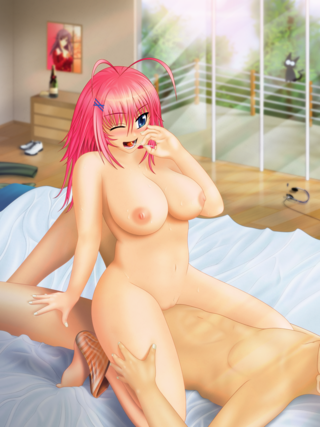
Hentai is a style of Japanese pornographic anime and manga. In addition to anime and manga, hentai works exist in a variety of media, including artwork and video games.
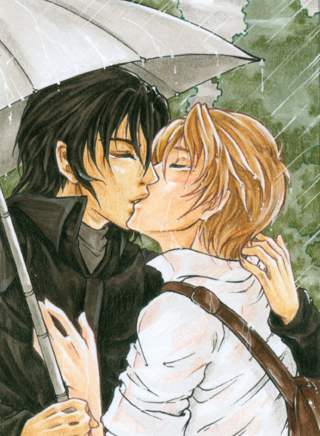
Boys' love, also known by its abbreviation BL, is a genre of fictional media originating in Japan that features homoerotic relationships between male characters. It is typically created by women for a female audience and is thus distinct from homoerotic media marketed to gay men, though BL does also attract a male audience and can be produced by male creators. BL spans a wide range of media, including manga, anime, drama CDs, novels, video games, television series, films, and fan works.
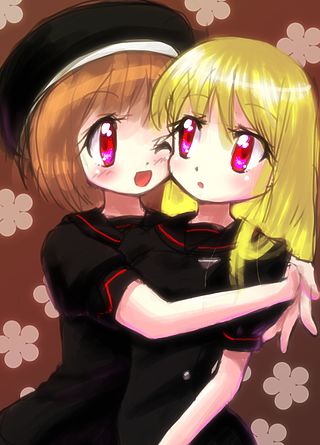
Yuri, also known by the wasei-eigo construction girls' love, is a genre of Japanese media focusing on intimate relationships between female characters. While lesbian relationships are a commonly associated theme, the genre is also inclusive of works depicting emotional and spiritual relationships between women that are not necessarily romantic or sexual in nature. Yuri is most commonly associated with anime and manga, though the term has also been used to describe video games, light novels, and literature.
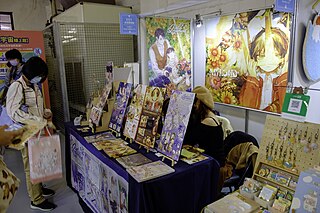
Shotacon, abbreviated from Shōtarō complex, is, in Japanese contexts, the attraction to young boy characters, or media centered around this attraction. The term refers to a genre of manga and anime wherein prepubescent or pubescent male characters are depicted in a suggestive or erotic manner, whether in the obvious role of object of attraction, or the less apparent role of "subject".
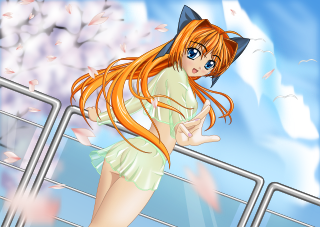
Ecchi is a slang term in the Japanese language for playfully sexual actions. As an adjective, it is used with the meaning of "sexy", "dirty" or "naughty"; as a verb, ecchi suru means "to have sex", and as a noun, it is used to describe someone of lascivious behavior. It is softer than the Japanese word ero, and does not imply perversion in the way hentai does.
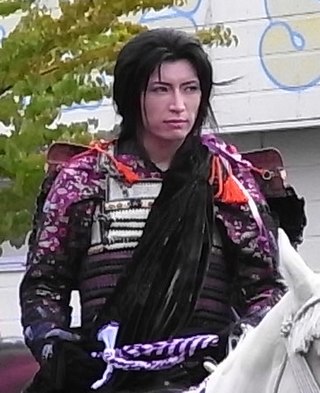
Bishōnen is a Japanese term literally meaning "beautiful youth (boy)" and describes an aesthetic that can be found in disparate areas in East Asia: a young man of androgynous beauty. This word originated from the Tang dynasty poem Eight Immortals of the Wine Cup by Du Fu. It has always shown the strongest manifestation in Japanese pop culture, gaining in popularity due to the androgynous glam rock bands of the 1970s, but it has roots in ancient Japanese literature, the androsocial and androerotic ideals of the medieval Chinese imperial court and intellectuals, and Indian aesthetic concepts carried over from Hinduism, imported with Buddhism to China. Today, bishōnen are very popular among girls and women in Japan. Reasons for this social phenomenon may include the unique male and female social relationships found within the genre. Some have theorized that bishōnen provide a non-traditional outlet for gender relations. Moreover, it breaks down stereotypes surrounding feminine male characters. These are often depicted with very strong martial arts abilities, sports talent, high intelligence, dandy fashion, or comedic flair, traits that are usually assigned to the hero/protagonist role.
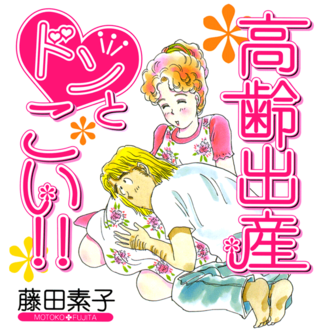
Josei manga, also known as ladies' comics (レディースコミック) and its abbreviation redikomi , is an editorial category of Japanese comics that emerged in the 1980s. In a strict sense, josei refers to manga marketed to an audience of adult women, contrasting shōjo manga, which is marketed to an audience of girls and young adult women. In practice, the distinction between shōjo and josei is often tenuous; while the two were initially divergent categories, many manga works exhibit narrative and stylistic traits associated with both shōjo and josei manga. This distinction is further complicated by a third manga editorial category, young ladies (ヤングレディース), which emerged in the late 1980s as an intermediate category between shōjo and josei.

In Japan, pornography has unique characteristics that readily distinguish it from western pornography. Pornographic films are known as "adult videos" (AV) in Japan, so Japanese adult videos (JAV) refers to the Japanese Adult Video industry. Animated films are referred to as hentai in English, but in Japan the terms "adult anime" and "erotic animation" are used. In addition to pornographic videos and magazines featuring live actors, there are now categories of pornographic manga and anime, and pornographic computer games.
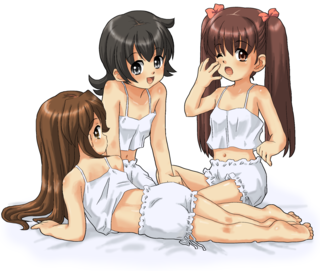
In Japanese popular culture, lolicon is a genre of fictional media which focuses on young girl characters, particularly in a sexually suggestive or erotic manner. The term, a portmanteau of the English-language phrase "Lolita complex", also refers to desire and affection for such characters, and their fans. Associated mainly with stylized imagery in manga, anime, and video games, lolicon in otaku culture is generally understood as distinct from desires for realistic depictions of young girls, or real young girls as such, and is associated with moe, or affection for fictional characters, often bishōjo characters in manga or anime.

Tentacle erotica is a type of pornography most commonly found in Japan that integrates traditional pornography with elements of bestiality, fantasy, horror, and science fiction. It is found in some horror or hentai titles, with tentacled creatures having sexual intercourse, predominantly with females or, to a lesser extent, males. Tentacle erotica can be consensual but mostly contains elements of rape.
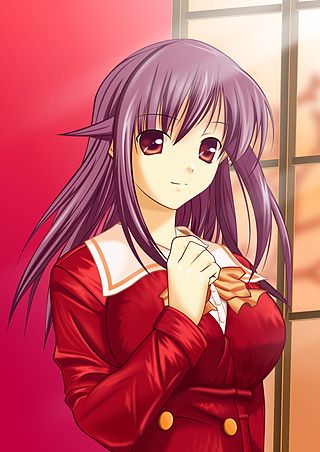
In Japanese popular culture, a bishōjo, also romanized as bishojo or bishoujo, is a cute girl character. Bishōjo characters appear ubiquitously in media including manga, anime, and computerized games, and also appear in advertising and as mascots, such as for maid cafés. An attraction towards bishōjo characters is a key concept in otaku subculture.
A bishōjo game or gal game is "a type of Japanese video game centered on interactions with attractive girls".
The following is a glossary of terms that are specific to anime and manga. Anime includes animated series, films and videos, while manga includes graphic novels, drawings and related artwork.
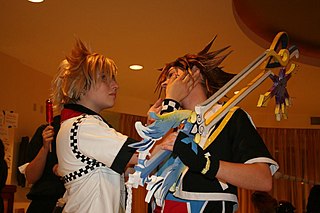
Boys' love (BL), a genre of male-male homoerotic media originating in Japan that is created primarily by and for women, has a robust global fandom. Individuals in the BL fandom may attend conventions, maintain/post to fansites, create fanfiction/fanart, etc. In the mid-1990s, estimates of the size of the Japanese BL fandom were at 100,000 to 500,000 people. Despite increased knowledge of the genre among the general public, readership remained limited in 2008.
Bara is a colloquialism for a genre of Japanese art and media known within Japan as gay manga (ゲイ漫画) or gei komi. The genre focuses on male same-sex love, as created primarily by gay men for a gay male audience. Bara can vary in visual style and plot, but typically features masculine men with varying degrees of muscle, body fat, and body hair, akin to bear or bodybuilding culture. While bara is typically pornographic, the genre has also depicted romantic and autobiographical subject material, as it acknowledges the varied reactions to homosexuality in modern Japan.
Sexuality in Japan developed separately from that of mainland Asia, as Japan did not adopt the Confucian view of marriage, in which chastity is highly valued. Monogamy in marriage is often thought to be less important in Japan, and sometimes married men may seek pleasure from courtesans. Prostitution in Japan has a long history, and became especially popular during the Japanese economic miracle, as evening entertainments were tax-deductible. Decreased sex drive in the 21st century has been blamed for the low Japanese birth rate and declining growth of the Japanese population.
LGBT Culture in Japan has recently begun to distinguish. The Japanese adopted the English term gender to describe cultural concepts of feminine and masculine. Previously, sei was used to distinguish the binary biological sexes, female and male, as well as the concept of gender. Ai Haruna and Ayana Tsubaki, two high-profile transgender celebrities, have gained popularity and have been making the rounds on some very popular Japanese variety shows. As of April 2011, Hiromi, a fashion model, came out as a lesbian. There is a genre of anime and manga that focuses on gay male romance known as yaoi.
The following outline is provided as an overview of and topical guide to human sexuality:

Otokonoko is a Japanese term for men who have a culturally feminine gender expression. This includes, among others, males with feminine appearances, or those cross-dressing. "Otokonoko" is a play on the word 男の子, which is also pronounced otokonoko; in the slang term, the kanji for "child" (子) is substituted with "daughter"/"girl" (娘).
In anime and manga, the term "LGBTQ themes" includes lesbian, gay, bisexual and transgender material. Outside Japan, anime generally refers to a specific Japanese-style of animation, but the word anime is used by the Japanese themselves to broadly describe all forms of animated media there. According to Harry Benshoff and Sean Griffin, the fluid state of animation allows flexibility of animated characters to perform multiple roles at once. Manga genres that focus on same-sex intimacy and relationships resulted from fan work that depicted relationships between two same-sex characters. This includes characters who express their gender and sexuality outside of hetero-normative boundaries. There are also multiple sub genres that target specific consumers and themes: yaoi, yuri, shoujo-ai, shonen-ai, bara, etc. LGBT-related manga found its origins from fans who created an "alternative universe" in which they paired their favorite characters together. Many of the earliest works that contained LGBT themes were found in works by dōjinshi who has specifically written content outside the regular industry. The rise of yaoi and yuri was also slowed due to censorship laws in Japan that make it extremely hard for Japanese manga artists ("mangakas") and others to create work that is LGBT themed. Anime that contained LGBTQ content was changed to meet international standards. However, publishing companies continued to expand their repertoire to include yuri and yaoi, and conventions were created to form a community and culture for fans of this work.













